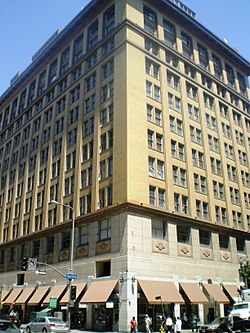A.G. Bartlett Building facts for kids
Quick facts for kids A.G. Bartlett Building |
|
|---|---|
 |
|
| Alternative names | The Bartlett Bartlett Building Lofts Seventh Street Lofts Union Oil Building |
| General information | |
| Status | Complete |
| Type | Residential condominiums |
| Location | 215 West Seventh Street Los Angeles, California |
| Coordinates | 34°02′41″N 118°15′06″W / 34.0446°N 118.2517°W |
| Completed | 1911 |
| Height | |
| Roof | 57.9 m (190 ft) |
| Technical details | |
| Floor count | 14 |
| Floor area | 160,000 sq ft (15,000 m2) |
| Design and construction | |
| Architect | John B. Parkinson Edwin Bergstrom |
| Other information | |
| Number of units | 130 |
|
A.G. Bartlett Building
|
|
|
U.S. Historic district
Contributing property |
|
| Architectural style | Beaux Arts |
| Part of | Spring Street Financial District (ID79000489) |
| Designated CP | 1979 |
The A.G. Bartlett Building is a tall building in Downtown Los Angeles, California. It has 14 floors. When it was finished in 1911, it was the tallest building in Los Angeles for five years!
It is located at 215 West 7th Street. This building is part of a special area called the Spring Street Financial District. This district is important because it is listed on the National Register of Historic Places. This means it is recognized as a place with historical value.
Building Design and History
The Bartlett Building was designed by two well-known architects. Their names were John B. Parkinson and Edwin Bergstrom. They chose a style called Beaux Arts. This design style was popular in the late 1800s and early 1900s. It often features grand and detailed designs.
From Offices to Homes
For many years, the building was used for offices. But in 2002, it got a big makeover. It was changed into 130 homes. These homes are called residential loft condominium units. A condominium is like an apartment that you own.
The ground floor of the building also has shops. This change was possible because of a rule in Los Angeles. It is called the Adaptive Reuse Ordinance. This rule helps old buildings find new uses. This way, important historic buildings can be saved.

